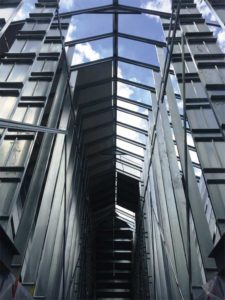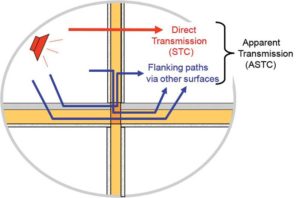Cold-formed steel design for acoustic code compliance

Photo courtesy Steelform Building Products
Broad trends
One key experimental takeaway is continuous surfaces between rooms are a threat to effective acoustic separation.
Experimental results across a variety of constructions make it clear a subfloor which is continuous across the junction can cause serious flanking sound transmission via the floor surfaces of a wall/ceiling junction with continuous subfloor, when compared to a wall/ceiling junction with discontinuous subfloor. With a continuous subfloor, the ASTC values were at the lower limit of acceptability. Breaking the subfloor with an intervening wall assembly can provide significant ASTC value, on the order of 15 to 20 points.
The flanking transmission at wall/wall junctions also depends significantly on the way gypsum board is attached to the wall framing. Gypsum board continuous across the junction was shown to decrease the ASTC rating by about 30 points compared with gypsum board interrupted at the junction. Continuous gypsum board on flanking walls provides an effective path for sound transmission between adjacent rooms and can significantly affect the apparent sound insulation, independent of the design of the separating wall. When the gypsum board and wall studs are well-separated, ASTC values for the wall-to-wall path can be reduced by almost half.
In loadbearing junctions, the continuity of the joists affects both the flanking sound transmission via the floor surfaces and the transmission via the ceiling. Joists continuous across the junction allow sound to travel uninterrupted, and therefore should be avoided where possible. In the study, ASTC values for the ceiling-to-ceiling path for discontinuous joists were 10 points higher than for continuous joists.
Continuous cavities are also conducive to sound transmission. Fortunately, many best practices in design to limit smoke and fire penetration also contribute to sound insulation by eliminating cavities that can provide acoustic flanking paths. Adding a fire block at the wall-to-floor junction does improve the STC flanking rating for floor-to-floor and ceiling-to-ceiling transmission, but its impact on the rating is often minimized by limited performance at some frequencies.

Image courtesy National Research Council Canada
Wall assemblies
Researchers measured direct sound transmission loss through wall assemblies comprised of a frame of cold-formed steel studs with gypsum board attached on both sides of the studs. The gypsum board was either fastened directly to the studs or supported on resilient metal channels. Most of the tested assemblies had sound absorbing material in the cavities between a single row of loadbearing cold-formed steel studs. (A complete description of all tested assemblies with individual STC test ratings is included in the report.)
Some significant takeaways from the research process include:
- adding extra layers of gypsum board in the construction detail had the most obvious effect on sound transmission loss values of cold-formed steel-framed walls;
- the change in STC rating due to filling the inter-stud cavities with sound absorbing material is similar to the improvement observed when the layers of gypsum board are doubled on both sides (partially filling the cavity provides most of the effect);
- although differences are evident among the sound transmission loss data with the three tested types of sound absorbing materials (glass, mineral, and cellulose fibre), the differences are insignificant in the sound frequencies dominant for determining STC ratings;
- adding sound absorbing material to the wall cavity has a major effect if the gypsum board on at least one side is mounted on resilient metal channels;
- thickness of the material used to fabricate the cold-formed steel studs has only a small effect (the STC rating increases by one to two points if studs with thinner steel are used);
- increasing the spacing between the cold-formed steel studs from 406 mm (16 in.) on centre (o.c.) to 610 mm (24 in.) o.c. increases the STC rating by one to two points for the walls used in this study, and a similar effect was observed when increasing the spacing between resilient metal channels;
- changing the depth of the steel studs from 92 to 152 mm (4 to 6 in.) studs can increase the STC rating by up to four points on walls with resilient channels; and
- the use of flat straps and bridging channels in loadbearing cold-formed steel-framed walls was found to have a negligible effect on the STC rating.







